Diego Oliva
UNIR-Net: A Novel Approach for Restoring Underwater Images with Non-Uniform Illumination Using Synthetic Data
Jan 15, 2025Abstract:Enhancing underwater images with non-uniform illumination (NUI) is crucial for improving visibility and visual quality in marine environments, where image degradation is caused by significant absorption and scattering effects. However, traditional model-based methods are often ineffective at capturing the complex illumination variations present in such images, resulting in limited visual improvements. On the other hand, learning-based approaches have shown promising results but face challenges due to the lack of specific datasets designed to effectively address the non-uniform illumination problem. To overcome these challenges, the Underwater Non-uniform Illumination Restoration Network (UNIR-Net) is introduced, a novel method that integrates illumination enhancement and attention blocks, along with visual refinement and contrast correction modules. This approach is specifically designed to mitigate the scattering and absorption effects that cause light attenuation in underwater environments. Additionally, the Paired Underwater Non-uniform Illumination (PUNI) dataset is presented, a paired resource that facilitates the restoration of underwater images under non-uniform illumination conditions. Extensive experiments conducted on the PUNI dataset and the large-scale real-world Non-Uniform Illumination Dataset (NUID), which contains underwater images with non-uniform illumination, demonstrate the robust generalization ability of UNIR-Net. This method outperforms existing approaches in both quantitative metrics and qualitative evaluations. Furthermore, UNIR-Net not only significantly enhances the visual quality of images but also improves performance in advanced computer vision tasks, such as semantic segmentation in underwater environments, highlighting its broad applicability and potential impact. The code of this method is available at https://github.com/xingyumex/UNIR-Net
MIAFEx: An Attention-based Feature Extraction Method for Medical Image Classification
Jan 15, 2025Abstract:Feature extraction techniques are crucial in medical image classification; however, classical feature extractors in addition to traditional machine learning classifiers often exhibit significant limitations in providing sufficient discriminative information for complex image sets. While Convolutional Neural Networks (CNNs) and Vision Transformer (ViT) have shown promise in feature extraction, they are prone to overfitting due to the inherent characteristics of medical imaging data, including small sample sizes or high intra-class variance. In this work, the Medical Image Attention-based Feature Extractor (MIAFEx) is proposed, a novel method that employs a learnable refinement mechanism to enhance the classification token within the Transformer encoder architecture. This mechanism adjusts the token based on learned weights, improving the extraction of salient features and enhancing the model's adaptability to the challenges presented by medical imaging data. The MIAFEx output features quality is compared against classical feature extractors using traditional and hybrid classifiers. Also, the performance of these features is compared against modern CNN and ViT models in classification tasks, demonstrating its superiority in accuracy and robustness across multiple complex classification medical imaging datasets. This advantage is particularly pronounced in scenarios with limited training data, where traditional and modern models often struggle to generalize effectively. The source code of this proposal can be found at https://github.com/Oscar-RamosS/Medical-Image-Attention-based-Feature-Extractor-MIAFEx
ALEN: A Dual-Approach for Uniform and Non-Uniform Low-Light Image Enhancement
Jul 29, 2024



Abstract:Low-light image enhancement is an important task in computer vision, essential for improving the visibility and quality of images captured in non-optimal lighting conditions. Inadequate illumination can lead to significant information loss and poor image quality, impacting various applications such as surveillance. photography, or even autonomous driving. In this regard, automated methods have been developed to automatically adjust illumination in the image for a better visual perception. Current enhancement techniques often use specific datasets to enhance low-light images, but still present challenges when adapting to diverse real-world conditions, where illumination degradation may be localized to specific regions. To address this challenge, the Adaptive Light Enhancement Network (ALEN) is introduced, whose main approach is the use of a classification mechanism to determine whether local or global illumination enhancement is required. Subsequently, estimator networks adjust illumination based on this classification and simultaneously enhance color fidelity. ALEN integrates the Light Classification Network (LCNet) for illuminance categorization, complemented by the Single-Channel Network (SCNet), and Multi-Channel Network (MCNet) for precise estimation of illumination and color, respectively. Extensive experiments on publicly available datasets for low-light conditions were carried out to underscore ALEN's robust generalization capabilities, demonstrating superior performance in both quantitative metrics and qualitative assessments when compared to recent state-of-the-art methods. The ALEN not only enhances image quality in terms of visual perception but also represents an advancement in high-level vision tasks, such as semantic segmentation, as presented in this work. The code of this method is available at https://github.com/xingyumex/ALEN.
FA-Net: A Fuzzy Attention-aided Deep Neural Network for Pneumonia Detection in Chest X-Rays
Jun 21, 2024Abstract:Pneumonia is a respiratory infection caused by bacteria, fungi, or viruses. It affects many people, particularly those in developing or underdeveloped nations with high pollution levels, unhygienic living conditions, overcrowding, and insufficient medical infrastructure. Pneumonia can cause pleural effusion, where fluids fill the lungs, leading to respiratory difficulty. Early diagnosis is crucial to ensure effective treatment and increase survival rates. Chest X-ray imaging is the most commonly used method for diagnosing pneumonia. However, visual examination of chest X-rays can be difficult and subjective. In this study, we have developed a computer-aided diagnosis system for automatic pneumonia detection using chest X-ray images. We have used DenseNet-121 and ResNet50 as the backbone for the binary class (pneumonia and normal) and multi-class (bacterial pneumonia, viral pneumonia, and normal) classification tasks, respectively. We have also implemented a channel-specific spatial attention mechanism, called Fuzzy Channel Selective Spatial Attention Module (FCSSAM), to highlight the specific spatial regions of relevant channels while removing the irrelevant channels of the extracted features by the backbone. We evaluated the proposed approach on a publicly available chest X-ray dataset, using binary and multi-class classification setups. Our proposed method achieves accuracy rates of 97.15\% and 79.79\% for the binary and multi-class classification setups, respectively. The results of our proposed method are superior to state-of-the-art (SOTA) methods. The code of the proposed model will be available at: https://github.com/AyushRoy2001/FA-Net.
A Novel Plagiarism Detection Approach Combining BERT-based Word Embedding, Attention-based LSTMs and an Improved Differential Evolution Algorithm
May 03, 2023



Abstract:Detecting plagiarism involves finding similar items in two different sources. In this article, we propose a novel method for detecting plagiarism that is based on attention mechanism-based long short-term memory (LSTM) and bidirectional encoder representations from transformers (BERT) word embedding, enhanced with optimized differential evolution (DE) method for pre-training and a focal loss function for training. BERT could be included in a downstream task and fine-tuned as a task-specific BERT can be included in a downstream task and fine-tuned as a task-specific structure, while the trained BERT model is capable of detecting various linguistic characteristics. Unbalanced classification is one of the primary issues with plagiarism detection. We suggest a focal loss-based training technique that carefully learns minority class instances to solve this. Another issue that we tackle is the training phase itself, which typically employs gradient-based methods like back-propagation for the learning process and thus suffers from some drawbacks, including sensitivity to initialization. To initiate the BP process, we suggest a novel DE algorithm that makes use of a clustering-based mutation operator. Here, a winning cluster is identified for the current DE population, and a fresh updating method is used to produce potential answers. We evaluate our proposed approach on three benchmark datasets ( MSRP, SNLI, and SemEval2014) and demonstrate that it performs well when compared to both conventional and population-based methods.
A new Hyper-heuristic based on Adaptive Simulated Annealing and Reinforcement Learning for the Capacitated Electric Vehicle Routing Problem
Jun 07, 2022



Abstract:Electric vehicles (EVs) have been adopted in urban areas to reduce environmental pollution and global warming as a result of the increasing number of freight vehicles. However, there are still deficiencies in routing the trajectories of last-mile logistics that continue to impact social and economic sustainability. For that reason, in this paper, a hyper-heuristic (HH) approach called Hyper-heuristic Adaptive Simulated Annealing with Reinforcement Learning (HHASA$_{RL}$) is proposed. It is composed of a multi-armed bandit method and the self-adaptive Simulated Annealing (SA) metaheuristic algorithm for solving the problem called Capacitated Electric Vehicle Routing Problem (CEVRP). Due to the limited number of charging stations and the travel range of EVs, the EVs must require battery recharging moments in advance and reduce travel times and costs. The HH implemented improves multiple minimum best-known solutions and obtains the best mean values for some high-dimensional instances for the proposed benchmark for the IEEE WCCI2020 competition.
HMS-OS: Improving the Human Mental Search Optimisation Algorithm by Grouping in both Search and Objective Space
Dec 03, 2021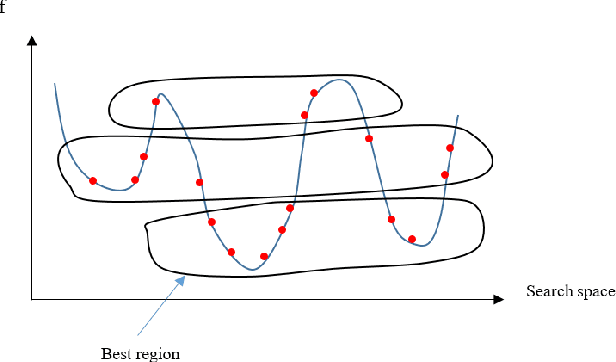
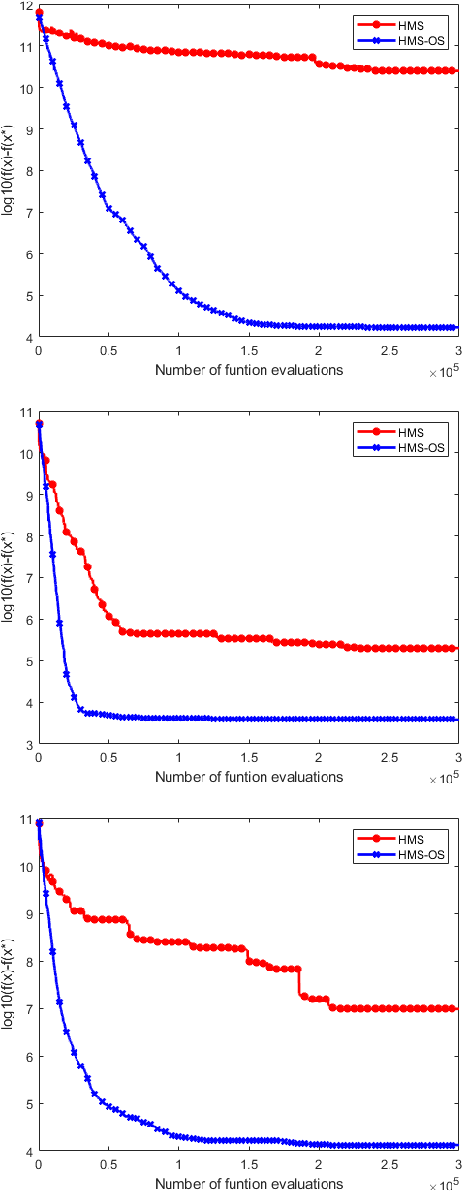
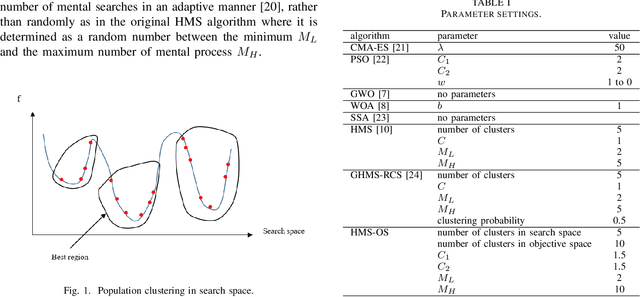

Abstract:The human mental search (HMS) algorithm is a relatively recent population-based metaheuristic algorithm, which has shown competitive performance in solving complex optimisation problems. It is based on three main operators: mental search, grouping, and movement. In the original HMS algorithm, a clustering algorithm is used to group the current population in order to identify a promising region in search space, while candidate solutions then move towards the best candidate solution in the promising region. In this paper, we propose a novel HMS algorithm, HMS-OS, which is based on clustering in both objective and search space, where clustering in objective space finds a set of best candidate solutions whose centroid is then also used in updating the population. For further improvement, HMSOS benefits from an adaptive selection of the number of mental processes in the mental search operator. Experimental results on CEC-2017 benchmark functions with dimensionalities of 50 and 100, and in comparison to other optimisation algorithms, indicate that HMS-OS yields excellent performance, superior to those of other methods.
Segmentation of Brain MRI using an Altruistic Harris Hawks' Optimization algorithm
Sep 17, 2021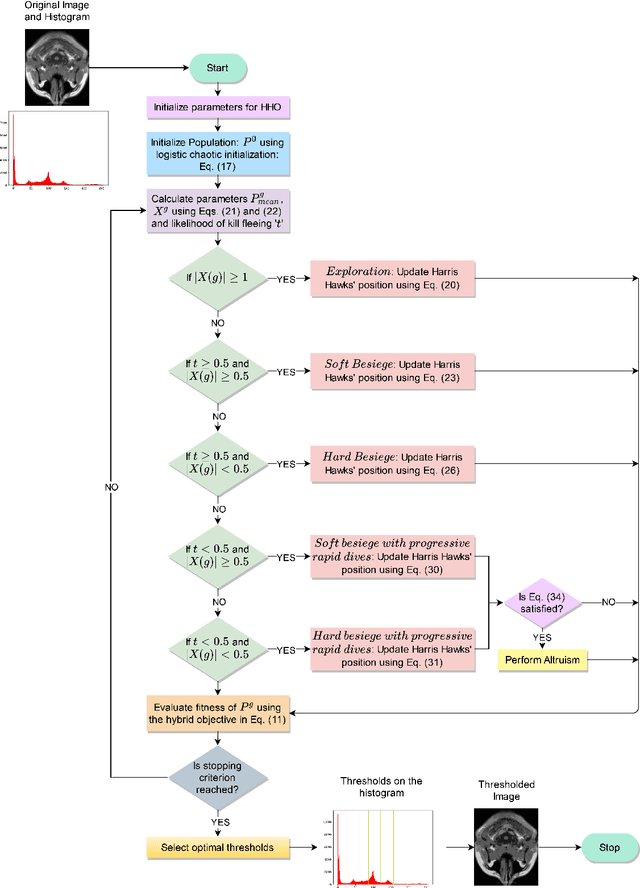


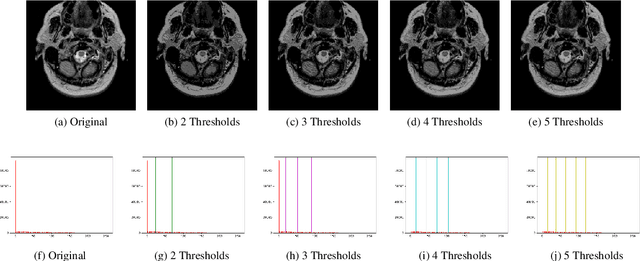
Abstract:Segmentation is an essential requirement in medicine when digital images are used in illness diagnosis, especially, in posterior tasks as analysis and disease identification. An efficient segmentation of brain Magnetic Resonance Images (MRIs) is of prime concern to radiologists due to their poor illumination and other conditions related to de acquisition of the images. Thresholding is a popular method for segmentation that uses the histogram of an image to label different homogeneous groups of pixels into different classes. However, the computational cost increases exponentially according to the number of thresholds. In this paper, we perform the multi-level thresholding using an evolutionary metaheuristic. It is an improved version of the Harris Hawks Optimization (HHO) algorithm that combines the chaotic initialization and the concept of altruism. Further, for fitness assignment, we use a hybrid objective function where along with the cross-entropy minimization, we apply a new entropy function, and leverage weights to the two objective functions to form a new hybrid approach. The HHO was originally designed to solve numerical optimization problems. Earlier, the statistical results and comparisons have demonstrated that the HHO provides very promising results compared with well-established metaheuristic techniques. In this article, the altruism has been incorporated into the HHO algorithm to enhance its exploitation capabilities. We evaluate the proposed method over 10 benchmark images from the WBA database of the Harvard Medical School and 8 benchmark images from the Brainweb dataset using some standard evaluation metrics.
Differential Evolution-based Neural Network Training Incorporating a Centroid-based Strategy and Dynamic Opposition-based Learning
Jun 29, 2021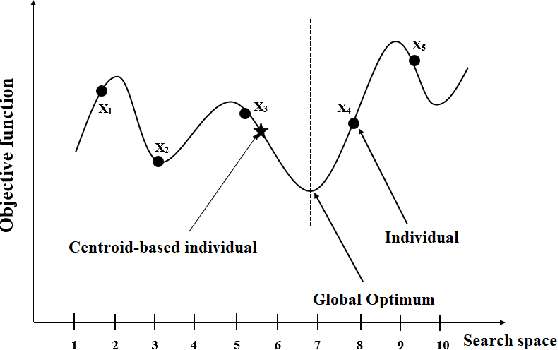
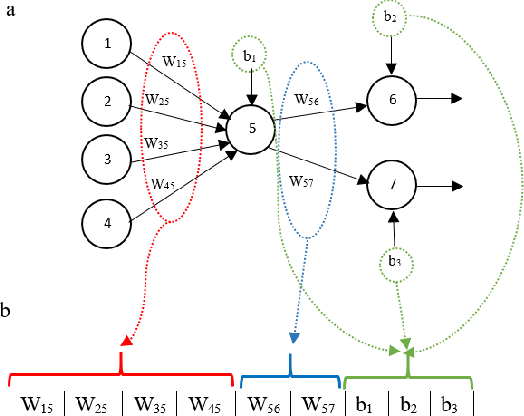
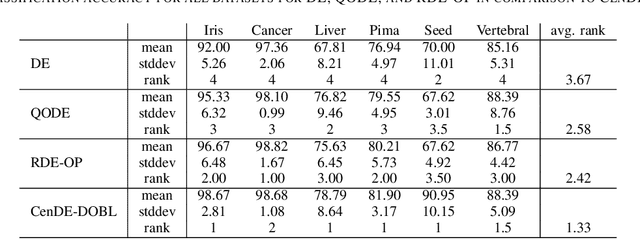
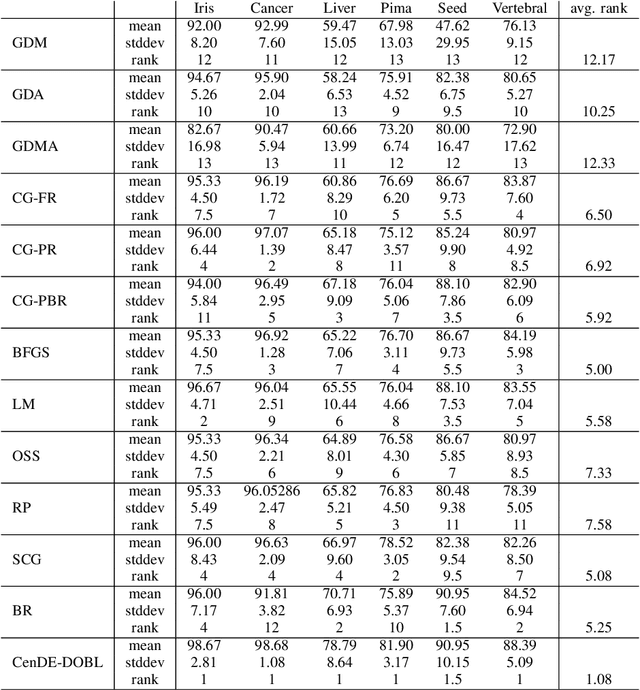
Abstract:Training multi-layer neural networks (MLNNs), a challenging task, involves finding appropriate weights and biases. MLNN training is important since the performance of MLNNs is mainly dependent on these network parameters. However, conventional algorithms such as gradient-based methods, while extensively used for MLNN training, suffer from drawbacks such as a tendency to getting stuck in local optima. Population-based metaheuristic algorithms can be used to overcome these problems. In this paper, we propose a novel MLNN training algorithm, CenDE-DOBL, that is based on differential evolution (DE), a centroid-based strategy (Cen-S), and dynamic opposition-based learning (DOBL). The Cen-S approach employs the centroid of the best individuals as a member of population, while other members are updated using standard crossover and mutation operators. This improves exploitation since the new member is obtained based on the best individuals, while the employed DOBL strategy, which uses the opposite of an individual, leads to enhanced exploration. Our extensive experiments compare CenDE-DOBL to 26 conventional and population-based algorithms and confirm it to provide excellent MLNN training performance.
A multilevel thresholding algorithm using Electromagnetism Optimization
Jun 24, 2014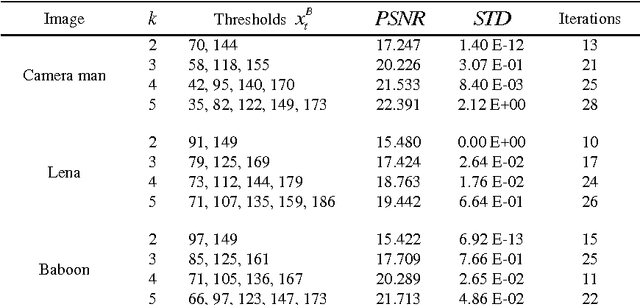
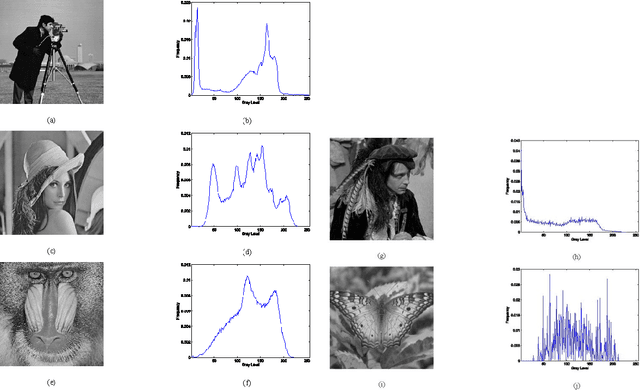
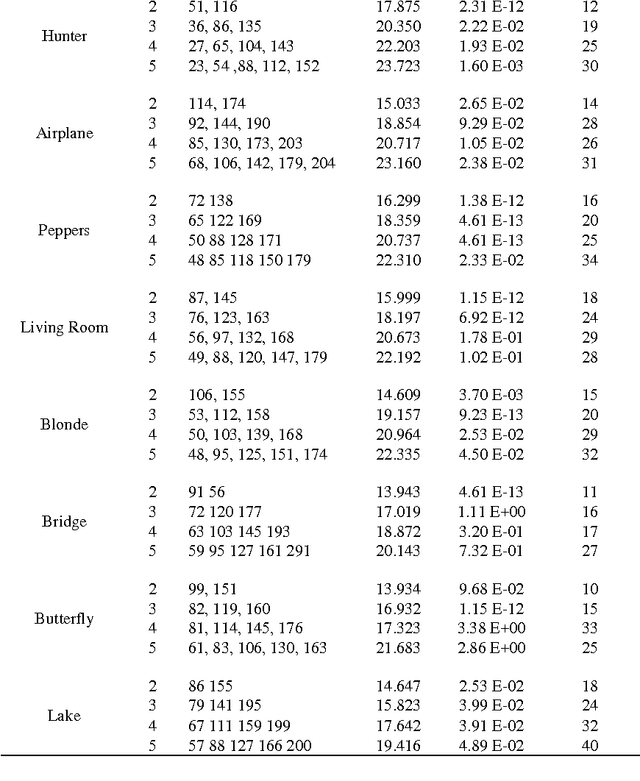
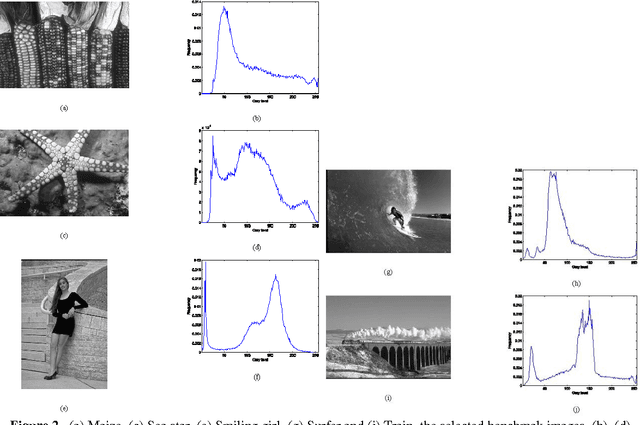
Abstract:Segmentation is one of the most important tasks in image processing. It consist in classify the pixels into two or more groups depending on their intensity levels and a threshold value. The quality of the segmentation depends on the method applied to select the threshold. The use of the classical implementations for multilevel thresholding is computationally expensive since they exhaustively search the best values to optimize the objective function. Under such conditions, the use of optimization evolutionary approaches has been extended. The Electromagnetism Like algorithm (EMO) is an evolutionary method which mimics the attraction repulsion mechanism among charges to evolve the members of a population. Different to other algorithms, EMO exhibits interesting search capabilities whereas maintains a low computational overhead. In this paper, a multilevel thresholding (MT) algorithm based on the EMO is introduced. The approach combines the good search capabilities of EMO algorithm with objective functions proposed by the popular MT methods of Otsu and Kapur. The algorithm takes random samples from a feasible search space inside the image histogram. Such samples build each particle in the EMO context whereas its quality is evaluated considering the objective that is function employed by the Otsu or Kapur method. Guided by these objective values the set of candidate solutions are evolved through the EMO operators until an optimal solution is found. The approach generates a multilevel segmentation algorithm which can effectively identify the threshold values of a digital image in a reduced number of iterations. Experimental results show performance evidence of the implementation of EMO for digital image segmentation.
* The figures have been shortened in order to fulfill the submission requirements
 Add to Chrome
Add to Chrome Add to Firefox
Add to Firefox Add to Edge
Add to Edge